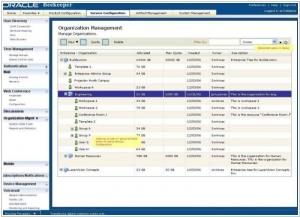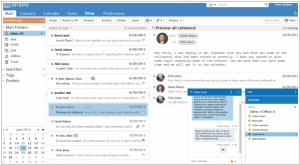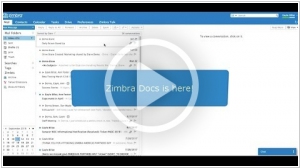Oracle Beehive vs Zimbra
September 14, 2023 | Author: Adam Levine
2

Oracle Beehive provides an integrated set of communication and collaboration services built on a single scalable, secure, enterprise-class platform. Beehive allows users to access their collaborative information through familiar tools while enabling IT to consolidate infrastructure and implement a centrally managed, secure, and compliant collaboration environment built on Oracle technology.
17

Zimbra Collaboration Server is an email and calendar server plus much more; think about it like a next-generation Microsoft Exchange server. In addition to email and calendar, it provides file sharing, tasks, contacts, social media, document management and simplified administrative controls all in an award winning webmail user interface built with the latest AJAX web technology. ZCS also provides mobility and syncs to desktop client applications; the server is deployed on commodity Linux and Mac server hardware.
Oracle Beehive and Zimbra are two popular collaboration platforms, each with its own set of strengths and features. Oracle Beehive is an enterprise-grade solution that offers a comprehensive suite of collaboration tools, including email, calendaring, document management, team collaboration, and unified communications. It leverages Oracle's expertise in enterprise software to provide a highly scalable and customizable solution that integrates well with other Oracle products. On the other hand, Zimbra is a powerful open-source collaboration platform that offers robust email management, calendaring, and file sharing capabilities. It provides a user-friendly interface, extensive customization options, and strong integration with other popular tools such as Outlook and mobile devices.
See also: Top 10 Email services
See also: Top 10 Email services
Oracle Beehive vs Zimbra in our news:
2019. Email collaboration software Zimbra added own document editors
Zimbra Network Edition has introduced an integrated, feature-rich office productivity suite called Zimbra Docs. The remarkable aspect is that it is available for free, eliminating the need for a separate MS Office license. With Zimbra Docs, users can now effortlessly create and edit documents, spreadsheets, and presentations directly within the Zimbra platform. It supports popular document formats such as xls, doc, ppt, and more. The suite includes various apps: Zimbra Writer for document editing, Zimbra Calc for spreadsheets, Zimbra Impress for presentations, and Zimbra Briefcase for converting and sharing files. At the core of this service is the Zimbra Docs server, which must be installed on dedicated nodes running RHEL 7 / CentOS 7, Ubuntu 16.04 LTS, or Ubuntu 18.04 LTS. In addition to its built-in office suite, Zimbra also offers integration with LibreOffice, providing users with another free office suite option.
2015. Synacor acquired Zimbra

The email and messaging software provider Zimbra, known for its open-source foundation, has been purchased by Synacor for a sum of $24.5 million. Synacor describes itself as a technology and monetization partner for video, internet, and communications providers, as well as device manufacturers and enterprises. According to Synacor officials, they intend to continue supporting the open-source version of Zimbra and provide technical assistance for Zimbra's Open Source Edition (OSE) through their value-added reseller (VAR) partners. Zimbra has previously been acquired by Telligent, VMware, and Yahoo. This recent acquisition comes shortly after the announcement that Verint has acquired Telligent (Zimbra Social) from Zimbra earlier in the week.
2010. VMware buying Zimbra from Yahoo

What does this deal signify? For Yahoo, it marks the end of their involvement in the Enterprise game. The company will now focus on its consumer portal and will not interfere with its new strategic partner, Microsoft (because Zimbra is an MS Exchange competitor). For VMWare, this represents another significant step towards reaching the elite status in the Cloud Computing market. VMWare, being the largest developer of virtualization systems used in public and private cloud platforms, has recently acquired Springsource to create its own web platform as an alternative to Google App Engine. By acquiring the widely popular open-source collaboration suite Zimbra, VMWare gains the opportunity to enter the Web applications market. The exact sale price has not been disclosed yet, but it is likely lower than the $350 million paid by Yahoo in 2006.
2009. Yahoo released Zimbra Desktop 1.0
Zimbra Desktop 1.0, an email and collaboration client, has transitioned from its beta phase and is now available for free download. Zimbra sets itself apart from Outlook and Gmail by offering users both online and offline email functionality. Acting as a centralized hub for email, contacts, and calendar information, Zimbra allows users to access Yahoo and Gmail contacts, calendars, and messages within its platform, along with POP or IMAP email from providers like AOL, Hotmail, or office accounts. Although syncing with certain third-party email and calendar services in Zimbra Desktop is still considered beta, such as Hotmail, Yahoo, and Google calendars, this release has expanded support for these integrations. A Zimbra representative clarified that these integrations are labeled beta as they rely on APIs not maintained by the Zimbra team.
2008. Zimbra Heads To The Cloud For Academic Institutions
Zimbra, the webmail and calendar company that was acquired by Yahoo in 2007, has introduced a new offering called Zimbra Hosted, specifically designed for academic institutions. This product enables schools to operate their webmail portals from the cloud, eliminating the need for on-site infrastructure or reliance on third-party hosting providers. By partnering with Zimbra and Yahoo, schools can now benefit from hassle-free server maintenance and operation. Zimbra is already serving more than 400 academic institutions, and earlier this year, it achieved a significant victory by being selected by Stanford as its email and calendar management system for students, surpassing competing services from Google and Microsoft Exchange. Zimbra's success can be attributed to its robust mobile support and enterprise-grade features.
2008. Yahoo Updates Calendar: Leverages Zimbra Technology
Yahoo has announced the closed beta launch of a major update to its online calendaring application, which will feature tighter integration with Yahoo Mail and other Yahoo services. The new calendar is built on the Zimbra platform, acquired by Yahoo in 2007, and supports iCalendar and CalDAV standards for interoperability with other calendaring services. Exciting new features include the ability to enhance calendars with Flickr photos, a built-in to-do list, and drag-and-drop support. Yahoo Calendar now also offers reminders via email, instant messaging, or SMS for important events. Furthermore, Yahoo is expanding sharing capabilities for groups to facilitate coordination. Initially, the new calendar will be available as a closed beta in select countries, with a gradual rollout planned for all Yahoo Mail users. Yahoo's VP for Yahoo Mail, John Kremer, emphasized the need for calendar redesign due to the increasing comfort and adoption of online calendaring and open standards. Yahoo aims to provide a cleaner, user-friendly interface with integrated features from Zimbra and plans to incorporate social aspects and content from other Yahoo properties in future updates. By leading the way in mainstream adoption of calendaring standards, Yahoo can shape the market and promote the use of open standards and online calendars.
2008. Yahoo Gives IMAP Access to All Users Through Zimbra Desktop
In recent news, Yahoo has announced that all free and paid Yahoo Mail users will now have access to their accounts offline through the Yahoo Zimbra Desktop. This marks the first time that all Yahoo users will have offline capabilities. The Zimbra Desktop, which operates on Windows, Mac, and Linux, utilizes the IMAP protocol, offering what many consider to be superior offline access compared to the previous POP access limited to paid Yahoo Plus accounts. Yahoo acquired Zimbra, an email and messaging company, in 2007, shortly after Zimbra introduced its offline features. The Zimbra Desktop is built on Mozilla Labs' Prism, similar to Google Gears, enabling offline access to web applications. In addition to Yahoo Mail, Zimbra supports other IMAP and POP accounts, as well as accounts hosted on Zimbra servers. While still in beta, the stability of the Zimbra Desktop is evident as it is now being released to all Yahoo users, with no crashes or major issues reported during testing. The Zimbra Blog outlines various updates and features, including built-in notifications and Windows-specific functionalities. However, the absence of calendar, task, file, and contact syncing limits the utility of the Zimbra Desktop. Critics may argue that Yahoo could have allowed users to use any email client for offline access without Zimbra. Nonetheless, this move provides Yahoo users with one option for offline email access and potentially justifies their investment in Zimbra.
2008. New Zimbra Version Utilizes iPhone’s Active Sync
With Apple expanding iPhone support for Microsoft Word, Excel, PowerPoint, PDF, and iWork to attract business users, Zimbra has seized the opportunity to enhance the iPhone's potential as a mobile business tool. As an open-source provider of email, calendar, and contact synchronization across devices, Zimbra has released optimized versions of its entire Zimbra Collaboration Suite, Network Edition Standard, and Professional for iPhone 2.0 software. By leveraging the new active sync capabilities, Zimbra aims to enhance business application usage on the iPhone. Additionally, Zimbra's iPhone optimization includes over-the-air synchronization of photos on mobile devices. While push-email is a well-known feature of smartphones, the added document support makes devices like the iPhone even more valuable for business purposes. By combining Apple's support with applications like Zimbra, the iPhone can better compete with established smartphones like the BlackBerry, especially if Apple aims to expand its dominance into the business sector.
2008. Zimbra Web e-mail goes mobile
Zimbra, a division of Yahoo, has unveiled a new version of its Web-based email client, ZimbraME (Java Mobile Edition), that is compatible with Java-enabled mobile phones and Apple's iPhone. Alongside the release, the company has made the source code of the product available. Users can also utilize the software in conjunction with the commercially-supported Zimbra Collaboration Suite 5.0, which was launched earlier in the year. By downloading the software on their Java-enabled phones, individuals can conveniently access email and utilize Zimbra's calendar functionality.
2008. Now Yahoo's, Zimbra takes mail and documents offline
Zimbra, the e-mail and collaboration software company acquired by Yahoo for $350 million, is staying on track with its game plan despite the potential Microsoft-Yahoo merger. Zimbra is launching a new version of its software that allows offline reading of emails and document creation from a web browser. The Zimbra Collaboration Suite 5.0 also introduces support for BlackBerry clients, Java 2 mobile-equipped phones, and integrated instant messaging. The company's focus remains unchanged, serving universities, businesses, and internet service providers with its server software. Zimbra aims to provide web-based alternatives to Microsoft Office and competes directly with the software giant in the university and business markets. Yahoo is incorporating Zimbra's technology into its consumer web offerings, with plans to integrate Zimbra's calendar application into Yahoo Mail. Zimbra's Desktop application, which enables the creation and sharing of text documents and embedded spreadsheets, now offers offline capabilities. Zimbra provides both an open-source version of its server software and a commercial edition for higher-end users. Despite the potential Microsoft-Yahoo merger, Zimbra's plans and objectives remain unaffected.



